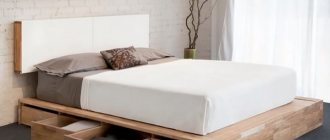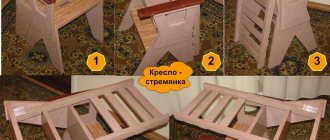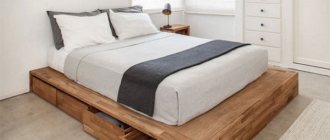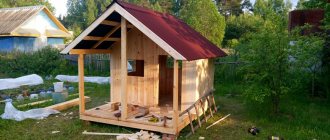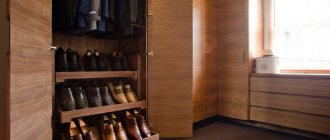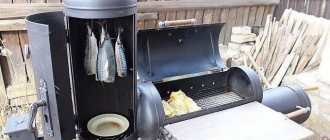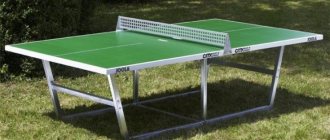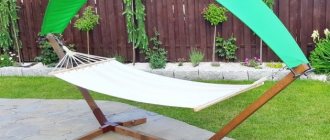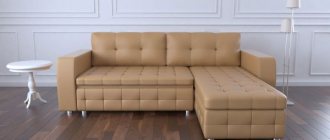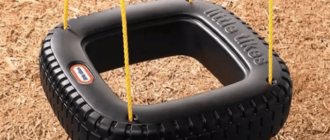A cradle is a small bed for a baby that is suspended in the air. This is one of the oldest and, unfortunately, most dangerous cribs for babies. If you do not follow the correct technology and use low-quality materials, the cradle may simply break off along with the baby. In this article we will tell you how to make a cradle for a newborn with your own hands, only it will stand on the floor for safety.
DIY baby cradle
The cradle for a baby to sleep has been known since ancient times. The peoples of the world brought their original ideas to the classic cradle, but the designs were the same. The cradle has been replaced by modern cribs for newborns. But the use of cribs is becoming popular again. This is a convenient product in which the baby is comfortable and cozy due to the close proximity of the walls. A small cradle takes up less space than a bulky bed. In this article I will tell you how to make a cradle for a baby with your own hands.
Types of cradles
Cradles are used from the birth of a baby until 8-9 months of age, when the child can already stand up and being in a cradle is not safe for him. Modern commercial cradles are equipped with electronics that can rock a child to sleep and respond to crying; the cradles come complete with remote controls, fasteners for canopies and other accessories. Classic models, like in the old days, are only capable of rocking a child. Cradles are divided into two types:
The main task when building a cradle is to make it safe. All wooden elements must be carefully processed; wood and paint materials are non-toxic.
Useful accessories
A canopy suspended above the cradle creates a cozy “house” and gives a feeling of security and peace. Thanks to it, a bright sunny day or light in the room will not prevent the child from sleeping peacefully.
Toys hanging on an arc built into the cradle will not leave any baby indifferent. In some models, they can move in a circle to soothing music, which helps the child fall asleep quickly. For those who are afraid of the dark, there are small star night lights.
Many modern electronic cradles have remote control using a remote control.
Hanging cradle
Use a cradle from an old stroller as a box, connect it with belts and hang it on a system of fasteners from the ceiling. If there is no cradle, we will make one from wood. To construct the fastener you will need:
In addition, prepare consumables (wood glue, dowels, corners, screws) and the necessary tools (jigsaw, drill, hammer drill, furniture stapler). Start by creating a drawing of the cradle, write down the size of each part. Cut out the necessary parts using a jigsaw from a plywood board. Start assembling the cradle structure from the bottom, glue the parts together with glue, and strengthen the connections with self-tapping screws. Attach the sides of the cradle. The structure is ready. Cover the inside of the cradle with foam rubber or padding polyester using a furniture stapler or glue. Cut out the future handles from the belt tape, measure the length of the handles from the ceiling to the required height of the cradle. Cover the ribbon with fabric prepared for decorating the cradle. Attach the handles to the bottom of the cradle with a furniture stapler. Use a hammer drill to make a hole in the ceiling, install fasteners from anchors, carabiners and angles. Secure the spring, inside which pass the safety cable. Hang the cradle on the spring. All that remains is to decorate it with fabric. The hanging cradle is ready!
Criterias of choice
All parents want their child to have a beautiful and comfortable sleeping place. The choice of a cradle is based on several basic criteria that need to be taken into account before purchasing.
Quality of mechanisms
Design safety is one of the most important criteria. Before purchasing, you must make sure that all fasteners and the box itself are secure. To strengthen the mechanism, double fasteners or a crossbar are often used.
A standard single fastening mechanism should consist of:
- hook;
- elastic spring;
- connecting belt (hook with spring);
- carbine;
- rings (for fastening cables).
If all the materials that were used in the production of fasteners are certified and comply with accepted safety standards, then even a classic single fastener will withstand the weight of a child.
Dimensions
Be sure to pay attention to the height of the sides. It should not be less than 30-40 cm. Babies often turn over in their sleep, and if the height is not enough, there is a possibility of falling out of the cradle.
When choosing a cradle, it is necessary to take into account the age and size of the child - some models are intended exclusively for infants, others are recommended for children from six months.
Additional functions
Some types of cradles are equipped with a mechanism for changing the position of the backrest, changing the height of the box above the floor, and seat belts; Some models have removable sides, handles for carrying the basket, and a removable inner fabric cover (for easy washing).
Certain crib designs can be used as a child seat in a car. The main thing is not to forget to securely fasten it.
Material for making the cradle
Material safety is another important criterion. It is better to give preference to natural ones, but if you still purchase a cradle made from an artificial one, you need to find out whether the child will be allergic to it.
The cradle should have a smooth, flat bottom and sides without any protruding parts that could cause injury. The interior upholstery is preferably cotton or linen, preferably soft, with environmentally friendly filling.
How to make a cradle for newborns with your own hands
In this article we will tell you how to make a cradle for newborns with your own hands in different ways. These are products made from waste material and wooden boards, ropes and thick fabric. There are options for weaving from wicker, and there are beautiful cradles made of wool rugs. The main condition for creating a crib is naturalness and environmental friendliness when choosing materials, so that the child does not inhale the “aromas” of synthetics or toxic varnishes and glues.
DIY cradles for newborns are made using natural wood or wool or cotton fabric. To fasten wooden parts, use only PVA glue (D3 or D4), and use only acrylic varnishes or paints for surfaces. They are completely odorless and non-toxic; they are widely used to cover children's toys and furniture.
Materials and tools
Master classes from experienced specialists contain useful tips on how to properly make a children's bed. Traditionally, the process begins with the selection of materials. Furniture must be safe and comfortable, so the most popular raw materials are:
- natural wood;
- metal;
- plastic;
- chipboard;
- MDF.
Models made from natural wood are environmentally friendly and safe. They do not have a specific odor or toxic elements in their composition. MDF boards are similar in performance to natural wood. Chipboard is somewhat worse, since it contains formaldehyde-based resins. When properly processed, the slabs are safe and cost less than other materials.
A wooden bed is the best choice, but this option will be quite expensive. Very beautiful colored models of different shapes and shades are assembled from plastic, but this material is toxic. It is difficult to choose high-quality synthetic raw materials.
In addition to materials, the master will need:
- special glue;
- self-tapping screws;
- drill;
- roulette;
- sandpaper;
- accessories;
- stain;
- brush.
Barrel version
A rocking crib for a baby made from a barrel will look very impressive. This DIY cradle for newborns is made up of two main parts. This is the barrel itself, from which a large piece has been cut off, and a wooden stand made of two strong legs and a lintel.
The barrel is attached to the side legs with dowels and mini-fixes made of hard wood. You can screw it on with bolts, securing it with nuts on both sides, adding a lock nut or a lock nut to make the structure reliable.
The remaining parts can be screwed on with screws or, if you have carpentry skills, tied onto tenons. You already understand how to make a cradle for a newborn with your own hands; all that remains is to cover everything with a layer of varnish and line it with fabric from the inside. It is advisable to attach a quilt to prevent the child from hitting the hard walls of the barrel. Don't forget to thoroughly clean the edges of the metal hoops so that they don't tear the fabric and harm your baby.
Advantages and disadvantages
When making children's furniture, several factors must be taken into account:
- Children will taste the furniture.
The wood itself is soft, and a child’s teething will encourage him to damage the furniture even more often. The crib should be made from environmentally friendly materials. - Until the age of one year, the baby will constantly defecate in bed. And not every diaper or diaper will retain this amount of moisture. There will definitely be leaks. The wood will absorb liquid, which may cause the crib to become deformed. The wood can also rot, which will affect the health of your child.
- Child's age. If the crib is made for a newborn, it is worth considering the possibility of “transforming” it into a cradle.
Based on the above points, we can highlight the advantages of making a crib on your own:
- The bed can be made to individual parameters, with optional functionality.
- Making home furniture will require a much smaller budget.
- All processes are controlled by the parent. The end result will be an environmentally friendly and high-quality product.
Despite the obvious advantages, there are also disadvantages of home production:
- You will need a sufficient amount of free time to search for good material, as well as to progress the work process.
- It is necessary to carefully process each piece of wood so that there are no chips or protruding chips on it.
- To work, you must have minimal metalworking skills in working with wood.
Cradle-boat
Therefore, if you are a carpenter, then you will definitely like the idea of creating such a spectacular cradle boat, as it looks quite original. It is not difficult to make stands for the cradle; these are ordinary legs with a jumper, the upper part of which is slightly raised and rounded. But it’s difficult to make the curved edges of the boat itself. You must have a steam generator and a chamber to steam the board and bend it according to the template of the required size. After cooling, the board remains curved.
Such a cradle is attached to cotton ropes threaded through holes drilled in the boards. To make it more similar to a real boat, small blocks were used, but they serve only a decorative function, since the cradle can neither lower nor rise.
Review of the best models
The range of bassinets offered by manufacturers is varied, but the following five models have received the most positive customer reviews.
Virinea
The sleeping place is a one-piece wicker basket made by hand from willow wicker with steel fastenings. Available in two sizes: standard and extended. Can be made to order. This is a completely natural classic version of the cradle that does not require special care. Suitable for babies up to six months.
Cradle made of slats
For those who like to make wooden structures, there is another option for an original baby crib. It consists of two semicircular planks, for which several boards were first glued together, and then they were cut out from the resulting shields according to a pattern. The next step will be to connect them to each other with a number of identical slats, screwed on with screws on both sides. The bottom of the crib is made flat.
For beauty, stars were cut out on the sides with a jigsaw. All slats must be thoroughly cleaned so that the crib is smooth and safe for the baby.
Carrycot for newborns
It’s easy to make a crib like the one in the photo below with your own hands. The wooden part of the structure is represented by two identical frames, which are connected at the central side points with bolts. They are held in an upright position by metal folding drawers, screwed to the top of the structure.
If you want to attach a canopy, you will also have to make a corner from slats with a central round stick for putting on the fabric. This design easily folds in half and can be taken with you outdoors or to the country. The cradle itself is made of thick fabric; satin or linen are suitable. A children's mattress is placed on the bottom.
Fabric pendant
You can sew a cradle for newborns with your own hands (photo below) from thick fabric, securing it to a floor beam or ceiling using strong ropes. So that the child can be rocked to sleep, a spring is attached at the junction of all the cords. Be sure to properly strengthen all the knots so that the child is safe and does not fall out of the bed.
The cradle is sewn from rectangular pieces of fabric, and attached to wooden round sticks with sewn wide loops. A mattress is placed at the bottom of the crib. If desired, also sew a canopy, which is simply hung on a spring in the center.
Macrame cradle
Many women are fond of weaving cords, so it is not surprising that the cradle for a newborn baby was made using the macrame technique. For this work you will need natural, durable cotton rope. The main threads are attached to selected hoops made of wire.
When the required height of the crib is reached, attach the lower hoop and weave a tightly mesh for the bottom. When the product is ready, insert the cut piece of plywood. Be sure to clean the edges with sandpaper; it is best to cover it with acrylic paint. Lastly, work on the bottom decorative fringe and make strong ropes to attach the crib to a hook on the ceiling.
Cocoon cradle for newborns
It’s easy to sew a comfortable portable cradle with your own hands, which is popularly called a cocoon, since it seems to hug the baby from all sides. You can take it with you on the road, on vacation in nature, or put it on the bed next to your mother.
Despite all the apparent complexity, sewing such a cradle is not at all difficult. You will need thick cotton fabric of one or two colors, a zipper, tape for tightening the corners of the cocoon, padding polyester, foam rubber and batting. If you have a sewing machine and very basic sewing skills, then feel free to start sewing such a cocoon, you will definitely succeed.
Homemade bed-car
Few boys will refuse a car bed. And you don’t have to go to the store to please your child. Using plywood or MDF sheets, water-based paints and varnish, an ordinary sleeping place turns into a dream come true: a do-it-yourself children's bed in the shape of a Batmobile (or any other car) can be realized in a week of leisurely work in the evenings.
First, find an image of the car that suits you, find a program with the ability to visualize pictures. Having transferred the image, it can be divided into squares with a side of 100 mm - so that later it is easier to convert it to real scale. It’s most convenient if the entire part fits into a sheet of plywood or MDF you bought, it’s even better if you can make two side panels from one sheet... In general, select the dimensions, change the shape. Once you are satisfied with the result, you can transfer the design to the sheet.
It all starts with drawing the sheet into squares with a side of 100 mm.
Referring to the existing sheet, transfer all the lines from the paper to the plywood. At first the lines are thin, after you have more or less drawn everything, you can outline the resulting contours with a thick line - it will be easier to cut out. Although the details are needed in duplicate, there is no point in drawing the second one: having cut out the first one, we will outline it and get the second one.
This project also has overhead parts - we draw them separately. When everything is ready, take a jigsaw and cut along the contours.
Pattern-drawing of a cocoon
The figure below in the article clearly shows all the necessary dimensions for sewing a fabric cocoon for a child. Using this pattern, two identical parts are cut out of fabric. On the wrong side they are sewn along the edges, leaving only the flat lower part unsewn. The soft bottom of the cocoon will subsequently be inserted through this hole. This pocket will be closed with a snake, which needs to be sewn onto its edges.
Next, you need to roll up a “sausage” from padding polyester and insert it along the entire perimeter of the cradle, pressing it tightly against the side seam. Then only on the front side a seam is made along the line marked in blue chalk. All that remains is to cut the foam bottom to the required size, cover it with a layer of thin batting both above and below, and then insert it into the pocket reserved for this purpose in the center of the cocoon and fasten it with a zipper. A wide satin ribbon is sewn onto the edges of the thickened sides to tie a beautiful bow. This closes the cocoon from below.
The article presents several interesting examples of making cradles for newborn babies. Choose the manufacturing method you like and do the work yourself. Good luck!
Source
DIY cradle for a newborn: drawings with photos
A cradle is a small bed for a baby that is suspended in the air. This is one of the oldest and, unfortunately, most dangerous cribs for babies. If you do not follow the correct technology and use low-quality materials, the cradle may simply break off along with the baby. In this article we will tell you how to make a cradle for a newborn with your own hands, only it will stand on the floor for safety.
Pros and cons of making children's furniture yourself
The younger the child, the more time he spends in bed. When buying a ready-made crib, you cannot say with complete confidence that it is completely safe for your baby. So what are the advantages of a homemade crib? Let's compare both options:
Crib from the store
Positive points:
- There is no need to waste time on a finished bed.
Negative sides:
- there is no confidence in the quality of the material;
- reliability is in question;
- the quality of the coating leaves much to be desired;
- poor quality of bed manufacturing occurs;
- you always have to pay extra.
DIY children's bed
Pros:
- independent choice of material quality;
- the design is reliable;
- every detail is carefully processed;
- paint coatings are selected correctly, in compliance with sanitary requirements;
- minimal, justified costs for materials;
- pleasure from the process;
- acquisition of new skills.
Minuses:
- time-consuming.
Let's go to the lesson
You can see the process of making a cradle in the example of a master class. We took the diagram from the last drawing and simplified it a little.
We cut out the headboard and legs, then cover them with colorless transparent acrylic varnish.
Next we make the sides.
You can buy these round sticks at the store, then you will need to sand them and glue them to two strips.
Making the bottom of the cradle. As you can see, we make it not from one thick board, but from slats.
We drill holes and begin to assemble the crib.
This is what should happen at this stage.
Cut out the legs in the shape of the letter "L".
Cut out the swing mechanism.
At night, you can clamp the discs with clamps so that they stick better.
We present a photo of the cradle that we got, from different angles.
We sew the sides and mattress cover.
Sweet nest
The process of creating a nest for a cradle with your own hands can be followed using the example of a master class. For this we will need cotton fabric measuring 80*100 cm, you can take two pieces of one or more colors, openwork lace and satin ribbon about three meters, holofiber or padding polyester.
First, we make a pattern. It is perfect for kids. It can also be downloaded from the link below.
Then we baste two pieces of fabric and lace. The front side should face inward. We begin to stitch and overcast the fabric. You need to make very neat seams for beautiful edges. Next, turn the nest inside out and steam the edges.
Stepping back two cm from the edge, sew the seam. We'll need it a little later.
We cut out and round the edges a holofiber measuring 70*35 or use padding polyester. Now we fill the nest with it and make a couple of horizontal seams. Also, don’t forget to stitch the side of the cocoon.
Then we stretch the satin ribbon. To make this job easier, use a pin.
We stuff the sides and hand stitch the open edges.
We tie a bow with a satin ribbon. The wider you take the ribbon, the larger the bow you will get.
Also, do not forget that when there are large edges left, there is no need to trim them. Thanks to them, you can adjust the length of the nest.
We sewed this cute nest for a newborn ourselves. As you can see, there was nothing complicated in the sewing process. The result is simply impressive! And the edges of the nest can be crocheted.
We sew a mattress
An important part of any crib is the mattress . Not only a comfortable rest, but also the quality of the child’s sleep depends on it.
In order for your baby to scream less at night and feel good, you should carefully approach the issue of choosing materials for sewing a mattress with your own hands.
The only thing we have to lose is time, but it will come back a hundredfold. The experience gained will allow you not only to figure out how to make a mattress for a bed in a short time, but also, if necessary, to conduct a master class for one of your friends or acquaintances.
What is required for sewing?
To make a mattress you will need:
- Fabric for the cover.
- Sewing threads.
- Filler.
These are the main components from which you can make a good mattress for reasonable money. You will also need tools for sewing.
Devices
To sew a simple mattress 5 cm thick you will need:
- sharp scissors;
- needles;
- threads;
- chalk for making patterns.
The pattern of the material can be made after choosing the fabric, filling for the mattress, as well as making calculations on the amount of materials used.
What fabric and in what quantity?
For a child's sleeping area, it is worth choosing soft, breathable fabrics . These include calico or teak. One mattress will require a piece of canvas 3 meters long and 1 m wide. These figures are taken with a margin, for a mattress measuring 120 cm by 60 cm and 6 cm high.
It is necessary to wash the purchased fabric before the cutting and sewing process. The material will shrink and be cleaned of factory impurities. This process will prevent the fabric from shrinking after moisture gets on its surface.
Step by step guide
The entire process of making a mattress can be divided into several stages:
- Material counting.
- Making a pattern.
- Sewing and padding of a mattress.
Let's look at how to sew a mattress into a crib step by step.
Calculation of parameters and fabric
Within the framework of this article, a crib with specified parameters of a sleeping place is considered. Based on this, the mattress will have dimensions of 120 cm by 60 cm. The height can be chosen arbitrarily , but in this project it will be 5 cm.
According to the given parameters, a piece of canvas is obtained in the following sizes:
- Length : 120 cm (bottom side) + 120 cm (top side) + height on both sides 10 cm + allowance on each side 2.5 cm. It turns out a 260 cm canvas.
- Width : 60 cm + 5 cm allowance on both sides + 10 cm height on both sides. The total width is 75 cm.
Drawing up a diagram and pattern
The pattern is drawn with chalk on the inside of the fabric according to the stated dimensions. Before cutting the fabric, double check everything carefully.
The working process
The mattress is sewn like a large pocket, leaving an unsewn hole on one side. In this case, the fabric is folded in half and stitched inside out with a double stitch using a thin needle.
It turns out something like a huge pillowcase. They turn it back right side out and begin to lay out the filler. For filling, you can take ordinary cotton wool, polyurethane foam, batting or padding polyester . After dense stuffing, the pocket is sewn up. The result is a finished mattress.
